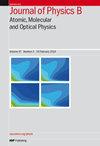基于雷德贝格原子的天线的多普勒灵敏度和谐振调谐
IF 1.5
4区 物理与天体物理
Q3 OPTICS
Journal of Physics B: Atomic, Molecular and Optical Physics
Pub Date : 2024-07-24
DOI:10.1088/1361-6455/ad6385
引用次数: 0
摘要
基于雷德贝格原子蒸汽电池的射频天线原则上可以达到超越任何传统导线天线的灵敏度,尤其是在需要很长的导线来适应波长增加的低频情况下。它们还具有其他理想特性,例如由非金属元件组成,因此外形较小。本文对雷德贝格天线的灵敏度进行了详细的理论研究,阐明了可使灵敏度累积提高 2-3 个数量级的参数机制,超过目前测试的配置。关键的洞察力在于优化组合两种经过充分研究的方法的优势:(i) 三束激光 "二维星形配置 "设置,当激光功率增加时,可在一定程度上补偿原子运动引起的多普勒展宽;(ii) 一对接近衰减的雷德堡级之间的共振耦合,通过局部振荡器调谐到感兴趣的入射信号。星形设置的优势是微妙的,因为它只能将整体灵敏度恢复到预期的多普勒限制值,而无法弥补其他显著的非共振减弱,即不同运动的原子子群在净信号中相互破坏性干扰。局部振荡器调谐的另一个独特优势是,它能使线宽窄得多,由 Rydberg 状态固有寿命设定的线宽可低至 ∼ 10 kHz,而不是由核心状态寿命设定的典型的 ∼ 10 MHz。直观地说,在这种设置下,两个雷德贝格态可以被调整为一个独立的高q腔,对天线谐振响应频率依赖性的研究支持了这一观点。要抑制各种外在的线宽效应并充分利用这种 "雷德贝格超外差 "响应,还需要一些实际的实验进展,特别是更大的∼1 厘米激光束宽。本文章由计算机程序翻译,如有差异,请以英文原文为准。
Doppler sensitivity and resonant tuning of Rydberg atom-based antennas
Radio frequency antennas based on Rydberg atom vapor cells can in principle reach sensitivities beyond those of any conventional wire antenna, especially at lower frequencies where very long wires are needed to accommodate the increasing wavelength. They also have other desirable features such as consisting of nonmetallic, hence lower profile, elements. This paper presents a detailed theoretical investigation of Rydberg antenna sensitivity, elucidating parameter regimes that could cumulatively lead to a sensitivity increase 2–3 orders of magnitude beyond that of currently tested configurations. The key insight is to optimally combine the advantages of two well-studied approaches: (i) three laser ‘2D star configuration’ setups that, when enhanced with increased laser power, to some degree compensate for atom motion-induced Doppler broadening, and (ii) resonant coupling between a pair of near-degenerate Rydberg levels, tuned via a local oscillator to the incident signal of interest. The advantage of the star setup is subtle because it only restores the overall sensitivity to the expected Doppler-limited value, compensating for additional significant off-resonance reductions where differently moving atom sub-populations destructively interfere with each other in the net signal. An additional unique advantage of local oscillator tuning is that it leads to vastly narrower line widths, as low as ∼10 kHz set by the intrinsic Rydberg state lifetimes, rather than the typical ∼10 MHz scale set by the core state lifetimes. Intuitively, with this setup the two Rydberg states may be tuned to act as an independent high-q cavity, a point of view supported by a study of the frequency-dependence of the antenna resonant response. There are a number of practical experimental advances, especially larger ∼1 cm laser beam widths, required to suppress various extrinsic line broadening effects and to fully exploit this ‘Rydberg superheterodyne’ response.
求助全文
通过发布文献求助,成功后即可免费获取论文全文。
去求助
来源期刊
CiteScore
3.60
自引率
6.20%
发文量
182
审稿时长
2.8 months
期刊介绍:
Published twice-monthly (24 issues per year), Journal of Physics B: Atomic, Molecular and Optical Physics covers the study of atoms, ions, molecules and clusters, and their structure and interactions with particles, photons or fields. The journal also publishes articles dealing with those aspects of spectroscopy, quantum optics and non-linear optics, laser physics, astrophysics, plasma physics, chemical physics, optical cooling and trapping and other investigations where the objects of study are the elementary atomic, ionic or molecular properties of processes.

 求助内容:
求助内容: 应助结果提醒方式:
应助结果提醒方式:


